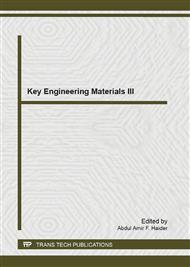p.349
p.354
p.359
p.364
p.370
p.375
p.378
p.382
p.389
Ti6Al4V Surface Hardness Improvement by Duplex Coating
Abstract:
Ti6Al4V alloy are among the most widely used materials in engineering applications. This is because their relatively beneficial properties. However, inadequate wear properties of Ti6Al4V alloy have largely constrained the application for this material. In this study, Plasma nitriding of the Ti6Al4V was performed using microwave plasma technique at 600°C for 1hour, 3 hours and 5 hours then followed with deposition of CrN on plasma nitrided samples for duplex coating purposes. Microstructural analysis and hardness measurement revealed that formation of Ti2N and TiN phases indicating the formation of compound layer is observed for substrate nitrided at temperature as low as 600°C 1 hour and a substantial increase on the surface hardness of plasma nitrided Ti6Al4V is observed with an increase of process time. The duplex coating obtained in this study has significant surface hardness property and superior as compared with CrN coatings deposited on as received Ti6Al4V.
Info:
Periodical:
Pages:
370-374
Citation:
Online since:
May 2013
Keywords:
Price:
Сopyright:
© 2013 Trans Tech Publications Ltd. All Rights Reserved
Share:
Citation:


